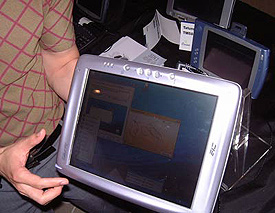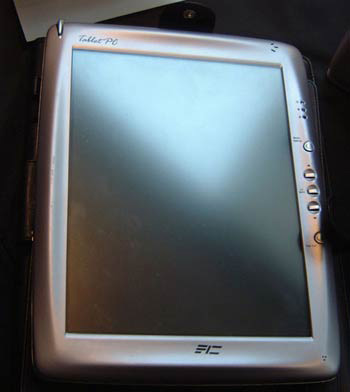W hen we first saw the FIC Crystal tablet PC at
Comdex Fall 2001 it was still very much in the prototype stage. Since that
meeting we have had the chance to put its brother, the Crusoe based Aqua Pad
through some serious testing. The full review on the Aqua Pad is here, and what
we saw from that cool magnesium encased "webpad" device was that it was best
suited to vertical markets than mainstream consumers.
hen we first saw the FIC Crystal tablet PC at
Comdex Fall 2001 it was still very much in the prototype stage. Since that
meeting we have had the chance to put its brother, the Crusoe based Aqua Pad
through some serious testing. The full review on the Aqua Pad is here, and what
we saw from that cool magnesium encased "webpad" device was that it was best
suited to vertical markets than mainstream consumers.
The FIC Crystal tablet on display by Tim Ou was
fully operational and loaded up with Windows XP. The tablet formfactor, and the
ability to treat it as a fully featured computer will probably see this unit
meet some good success with consumers when it is released.
Hand writing recognition will have to
advance by several levels before things will really equalize between tablets and PC's
but there is a strong potential there.
I was describing the FIC tablet to a friend of mine who is currently studying
IT at university right now and he really epitomized the needs, and
basic requirements the tablet PC will have to meet before consumers spend their money.
For him, the idea of
a tablet PC which (really) allowed him to switch between note
taking and diagram drawing was the allure. Notebooks make it difficult to transition from typing to
drawing down a diagram, and the current crop of tablets have awkward text entry
systems.
The real test for the tablet PC will be the lecture
hall - if this technology can stand up to a fast talking professor and a five
cent stick of chalk the computer industry will have a winner.

The Crystal tablet PC uses
a 10.4" TFT screen with XGA resolution (1024x768) which also has an
integrated touch screen component. To operate the TabletPC the user need
only use a standard EMD pen and write directly to the screen. Hand writting
recognition looks like it will be supported by Microsoft's Digital Ink. The
tablet is powered by TM5800 Crusoe processor running at 800MHz, features a
20GB notebook hard drive, and will support up to 128MB of on board
DDRAM.
